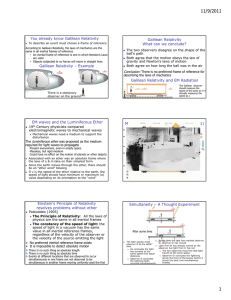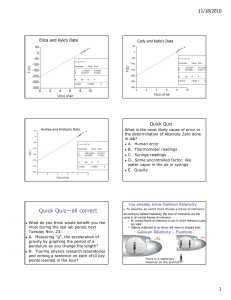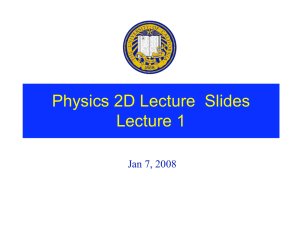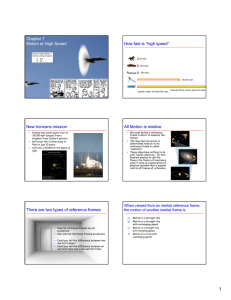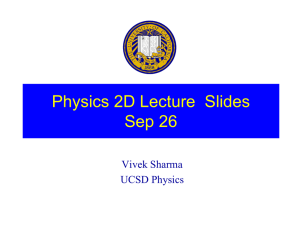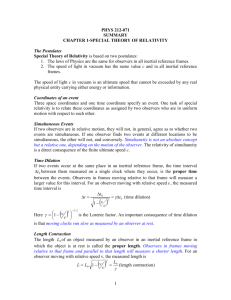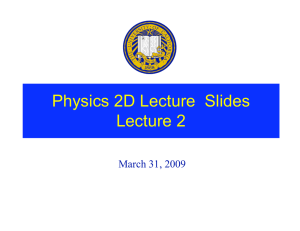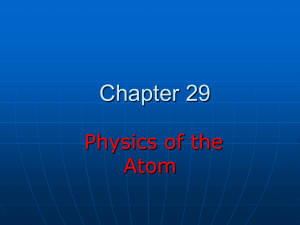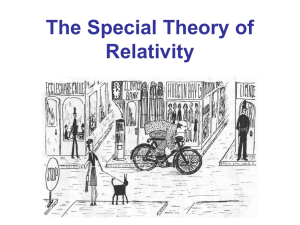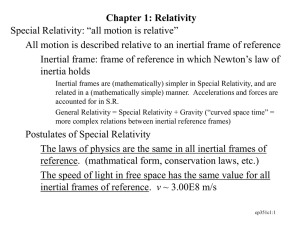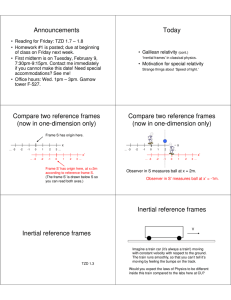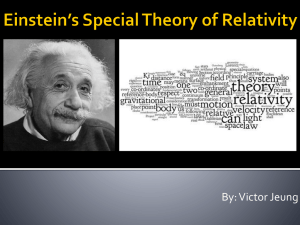inertial frame
advertisement
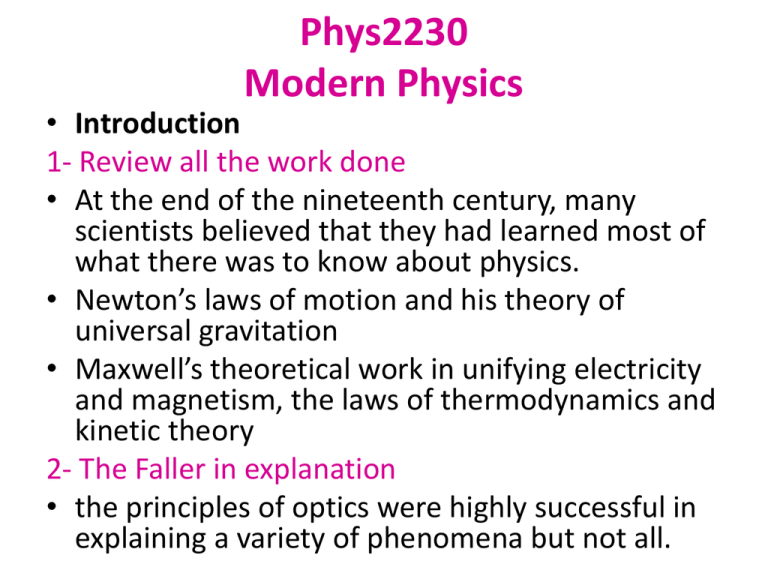
Phys2230 Modern Physics • Introduction 1- Review all the work done • At the end of the nineteenth century, many scientists believed that they had learned most of what there was to know about physics. • Newton’s laws of motion and his theory of universal gravitation • Maxwell’s theoretical work in unifying electricity and magnetism, the laws of thermodynamics and kinetic theory 2- The Faller in explanation • the principles of optics were highly successful in explaining a variety of phenomena but not all. • In 1900 Planck provided the basic ideas that led to the formulation of the quantum theory, and in 1905 Einstein formulated his brilliant special theory of relativity. • Within a few decades, these two theories inspired new developments and theories in the fields of atomic physics, nuclear physics, and condensed-matter physics • We introduce the special theory of relativity. The theory provides us with a new and deeper view of physical laws. • Although the concepts underlying this theory often violate our common sense, the theory correctly predicts the results of experiments involving speeds near the speed of light. We cover the basic concepts of wave and particles’ and atomic physics. Special Relativity 3- Why it was necessarily to have this special theory of relativity: • experiments show that the speed of the electron—as well as the speed of any other particle that has mass— always remains less than the speed of light, regardless of the size of the accelerating voltage. • Experimentally, the predictions of Newtonian theory can be tested at high speeds by accelerating electrons or other charged particles through a large electric potential difference. • According to Newtonian mechanics, if the potential difference is increased by a factor of 4, the electron’s kinetic energy is four times greater and its speed should double to 1.98c. • The existence of a universal speed limit has farreaching consequences. It means that the usual concepts of force, momentum, and energy no longer apply for rapidly moving objects. • Less obvious consequences include the fact that observers moving at different speeds will measure different time intervals and displacements between the same two events. Newtonian mechanics was contradicted by experimental observations, so it was necessary to replace it with another theory. The properties of the special theory of relativity: 1. This theory, experimental observations can be correctly predicted over the range of speeds from v = 0 to speeds approaching the speed of light. • At low speeds, Einstein’s theory reduces to Newtonian mechanics as a limiting situation. • if two observers moving relative to each other, normally, two such observers will measure different outcomes for the same event. 2. Special relativity is all about relating two such measurements The Principle of Galilean Relativity • To describe a physical event, we must establish a frame of reference مناط االسناد. • The inertial frame of reference مناط االسناد القصوريis one in which an object is observed to have no acceleration when no forces act on it. • OR the force that makes an object stay in the same position until another force makes it move or that makes an object continue at the same speed until another force slow it down • For example, when you perform an experiment in a laboratory, you select a coordinate system, or frame of reference, that is at rest with respect to the laboratory. • However, suppose an observer in a passing car moving at a constant velocity with respect to the lab were to observe your experiment. Would the observations made by the moving observer differ dramatically from yours? That is, if you found Newton’s first law to be valid in your frame of reference, would the moving observer agree with you? • According to the principle of Galilean relativity, this result is called the principle of Galilean relativity: The laws of mechanics must be the same in all inertial frames of reference. • Inertial frames of reference are those reference frames in which Newton’s laws are valid. such frames are those in which objects subjected to no forces move in straight lines at constant speed • Then if objects observed from these frames “inertial frame” obey Newton’s first law, the law of inertia. • Consider an airplane in flight, moving with a constant velocity, as in Figure 26.1a. If a passenger in the airplane throws a ball straight up in the air, the passenger observes that the ball moves in a vertical path. The motion of the ball is precisely the same as it would be if the ball were thrown while at rest on Earth. The law of gravity and the equations of motion under constant acceleration are obeyed whether the airplane is at rest or in uniform motion. • Now consider the same experiment when viewed by another observer at rest on Earth. This stationary observer views the path of the ball in the plane to be a parabola, as in Figure 26.1b. Further, according to this observer, the ball has a velocity to the right equal to the velocity of the plane. • Although the two observers disagree on the shape of the ball’s path, both agree that the motion of the ball obeys the law of gravity and Newton’s laws of motion, and even agree on how long the ball is in the air. We draw the following important conclusion : There is no preferred frame of reference for describing the laws of mechanics. THE SPEED OF LIGHT • Dose the concept of Galilean relativity in mechanics also applies to experiments in electricity, magnetism, optics, and other areas. • How about the speed of light . • according to electromagnetic theory, the speed of light always has the fixed value of 2.997 924 58 x 108 m/s in free space. • But this is in direct contradiction to common sense. • For example, suppose a light pulse is sent out by an observer in a boxcar moving with a velocity (Fig. 26.2). • The light pulse has a velocity relative to observer S’ in the boxcar. • According to Galilean relativity, the speed of the pulse relative to the stationary observer S outside the boxcar should be c + v. • This obviously contradicts Einstein’s theory, which postulates that the velocity of the light pulse is the same for all observers. • In order to resolve this paradox()مفارقة, we must conclude that either (1) the addition law for velocities is incorrect or (2) the laws of electricity and magnetism are not the same in all inertial frames. • Assume that the second conclusion is true; then a preferred reference frame must exist in which the speed of light has the value c, but in any other reference frame the speed of light must have a value that is greater or less than c. electromagnetic theory predicted that such waves must propagate through free space with a speed equal to the speed of light. However, the theory doesn’t require the presence of a medium for wave propagation. • In the 19th century, physicists thought that electromagnetic waves also required a medium in order to propagate. luminiferous ether أالثير المضئ • The ether was assumed to be present everywhere, even in empty space, and light waves were viewed as ether oscillations. • the ether would have to be a mass less but rigid medium with no effect on the motion of planets or other objects. v=(K/d), where k is Elasticity, d is the density. Then if the v is large, k must be large and d must be very small. This is not true for rigid medium. These are strange concepts indeed • a special frame of reference at rest with respect to the ether is called absolute frame. • The laws of electricity and magnetism would be valid in this absolute frame أالطار أو أالحداثيات المطلقه, but they would have to be modified in any reference frame moving with respect to the absolute frame. • all attempts to detect such changes and establish the existence of the ether (and hence the absolute frame) proved useless. • In conclusion, we see that the second hypothesis in our introduction to this section is false—and we now believe that the laws of electricity and magnetism are the same in all inertial frames. It is the simple classical addition laws for velocities that are incorrect and must be modified
